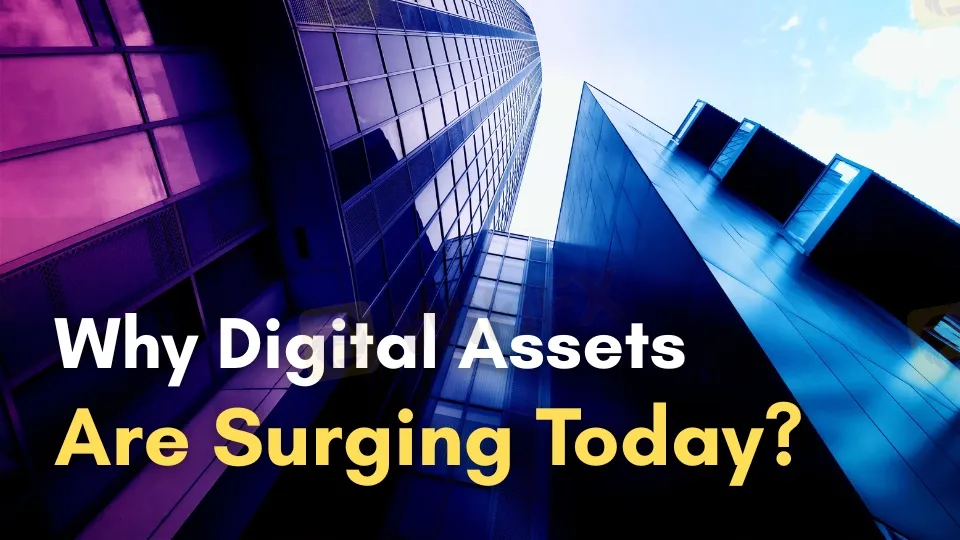Abstract:Explore the driving forces behind the 2025 surge in digital assets, from institutional investments to regulatory clarity and technological advances, shaping the market’s future.

This detailed analysis explores the multifaceted reasons behind the current surge in digital assets, including cryptocurrencies, tokenized assets, and related financial instruments, as observed in May 2025. The insights are drawn from recent trends, market dynamics, and institutional developments, with a critical lens to balance optimism with potential risks and controversies.
Institutional Investors Flock to Digital Assets for Diversification
Institutional adoption has emerged as a cornerstone of the digital asset surge, with significant allocations from hedge funds, pension funds, and banks. A survey by EY, published in June 2024 and reflecting trends into 2025, indicates that 51% of institutional investors expect to increase their allocations to digital assets and related products over the next 2-3 years.
This shift is driven by the growing interest in tokenized assets, particularly alternative assets, which offer portfolio diversification, access to new asset types, and enhanced liquidity. The survey details that 38% of respondents have already committed 1%-5% of their funds to digital assets, with 22% of hedge funds allocating more than 5%, highlighting a robust institutional appetite.
The preference for registered vehicles, such as Bitcoin Exchange-Traded Products (ETPs), has also grown, with 68% of institutions having or planning to invest in Bitcoin ETPs, up from 37% currently investing in spot crypto, expected to decrease to 32% in 2-3 years. This move towards regulated products aligns with the maturation of the market, making digital assets more accessible and appealing to traditional investors. However, the concentration of investments in a few major players, like BlackRock, raises concerns about market centralization and potential systemic risks if significant redemptions occur, a point of contention among market analysts.
This institutional embrace is likely a key driver, but skeptics argue that the hype could lead to speculative bubbles, necessitating robust valuation frameworks to protect investors.
Regulatory Clarity Emerges, Boosting Investor Confidence
Regulatory developments are pivotal in shaping the digital asset landscape, with 2025 marking a potential inflection point. The EU's Markets in Crypto Assets (MiCA) regulation, implemented in 2023, has provided a framework for crypto assets, addressing issues like market abuse and consumer protection, though it leaves decentralized finance (DeFi) and unbacked digital assets like bitcoin partially unaddressed.
In the U.S., the legislative framework remains under discussion, but President Trump's administration has taken a pro-crypto stance, significantly influencing market sentiment.
On January 20, 2025, Trump signed an executive order aiming to make the U.S. the “crypto capital of the planet,” promoting stablecoins, prohibiting a federal CBDC, and establishing the Presidential Working Group on Digital Asset Markets, chaired by Silicon Valley venture capitalist David Sacks, often called the “Crypto Czar”.

This policy shift, including the appointment of Paul Atkins as SEC chair, known for his supportive stance, has reduced regulatory uncertainty, encouraging Wall Street participation. The Federal Reserve's decision to rescind a 2022 supervisory letter requiring banks to notify regulators of crypto activities further signals a deregulatory push.
However, the lack of global regulatory harmonization remains a challenge, with property laws not yet updated for digital assets and cybersecurity risks needing strong standards. The European Central Bank has expressed concerns about potential financial “contagion” from the U.S.'s crypto embrace, highlighting a controversy around whether these policies will foster innovation or introduce systemic risks.
Technological Advancements Enhance Digital Asset Utility
Technological advancements in distributed ledger technology (DLT) and blockchain are underpinning the surge, enhancing the functionality and appeal of digital assets. Projects like CBDC cross-border collaborations, with almost 70% of central bank respondents expecting to issue a CBDC within the decade as per a 2023 survey, are testing new applications.
Project Mariana, for instance, tested cross-border trading and settlement of hypothetical euro, SGD, and CHF wholesale CBDCs on a public blockchain, while Project Agorá, involving BNP Paribas and 40 other private firms with 7 central banks, investigates tokenized commercial bank deposits integrated with tokenized wholesale bank money.
The EU's DLT Pilot Regime, in force since March 23, 2023, facilitates market infrastructures for listed security tokens, and the Canton Network, a privacy-enabled blockchain for institutional assets, rolled out its MainNet in 2024. These advancements improve settlement efficiency, enable programmable securities, and enhance interoperability, attracting traditional finance. However, challenges like the collapse of projects like Mantra's $OM token in April 2025 highlight risks of overhyping without sufficient infrastructure, underscoring the need for consumer protection and fraud prevention to sustain growth.
Macroeconomic Uncertainties Drive Demand for Digital Assets
Macroeconomic factors are significantly driving demand, with digital assets increasingly viewed as hedges against inflation, currency debasement, and fiscal deficits. Fidelity's 2025 outlook argues that “not making an allocation to Bitcoin could be riskier than making one,” citing debilitating inflation and currency debasement as key drivers.
The global market capitalization of cryptoassets reached a record $3.0 trillion in 2024, with Bitcoin passing $100,000, reflecting this trend.
The participation of over 1000 entities, including hedge funds, pension funds, and banks, with 80% retail investors but significant institutional involvement, indicates broad-based interest. Trump's proposed tariffs and doubts about the global dollar system's resilience have pushed banks to explore digital assets, with bitcoin often dubbed “digital gold.” However, its volatility and correlation with the Nasdaq suggest it may not always act as a safe haven, a point of contention among investors weighing its reliability against traditional assets.
Government Policies and Central Bank Actions Legitimize Digital Assets
Government and central bank initiatives are legitimizing digital assets, boosting investor confidence. Trump's executive order on January 20, 2025, revokes prior inconsistent Treasury policies, promotes stablecoins worldwide, and establishes a working group chaired by David Sacks, signaling strong U.S. support.
This aligns with actions like protecting public blockchain networks and self-custody, positioning digital assets as essential financial instruments.
Globally, 44 countries, including Russia, China, Australia, and Brazil, are running CBDC pilots, with Nigeria, Jamaica, and the Bahamas already launching digital currencies. Singapore is advanced, with its central bank experimenting with a digital Singapore dollar and around 40% of investors owning cryptocurrency, hosting 30 payment firms like Coinbase and Ripple. The ECB's response, pitching a digital euro, reflects competitive pressures, but concerns about financial contagion highlight potential risks, adding to the debate around global adoption.
Conclusion and Critical Perspective
The surge in digital assets as of May 2025 is a confluence of institutional adoption, regulatory clarity, technological advancements, macroeconomic uncertainties, and supportive government policies. While these factors create a bullish environment, critical examination reveals risks such as market volatility, regulatory uncertainty, and potential speculative bubbles. Investors should approach with caution, balancing optimism with due diligence, and stay informed about regulatory and technological developments to navigate this evolving landscape effectively.











